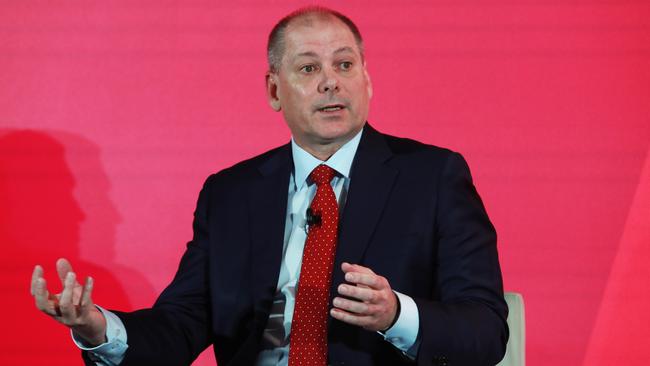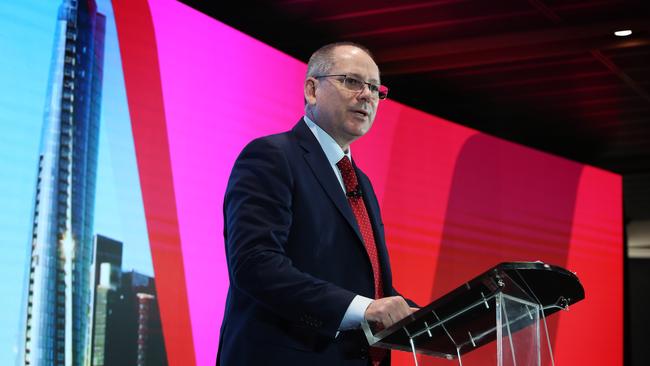No time to waste on energy transition, says Westpac CEO Peter King
Westpac CEO Peter King says Australia can’t afford to ‘muck around’ on a phased transition to more renewable sources of energy, as risks around energy supply linger.

Westpac chief executive Peter King has stressed Australia can’t afford to “muck around” on a phased transition to more renewable sources of energy, particularly as risks and shocks around energy supply linger.
Speaking after a bank update on Wednesday on digital and energy transition, Mr King said state and federal governments along with the business community had to get on with planning and securing cleaner sources of energy given the long lead times involved in some projects.
“How are we going to firm up the system? Where do we need to build poles and wires to move electricity? We can’t muck around because if some of these coal-fired power stations continue to have unscheduled outages, we’ll have a system that’s not reliable,” Mr King said.
His comments come as businesses and households grapple with issues in energy supply and cost across the country, and the federal government seeks to formalises a pledge to reduce greenhouse gas emissions by 43 per cent below 2005 levels by 2030.
Mr King outlined that more certainty on energy transition and targets was helpful to Westpac in funding markets.
“With the change in government, that change in policy on emissions, Australia seems to be going the right direction. But if there is a view that the country is not doing enough … it’ll be priced in capital markets. It’s not here today, but we can’t rule it out.”
Head of Westpac’s institutional bank Anthony Miller said there was still work to do around policy for long-term infrastructure assets, including in the energy sector.
“If you want more gas then you have to expand the pipes … a pipeline requires clarity that there’s a supply agreement for 30 years. That’s the policy vacuum and the vacuum that’s existed over the last five to 10 years,” he said.
Mr King said the bank had set “clear markers” for the cutting of carbon emissions for itself and its customers, as it accelerated a push toward broader net zero commitments.
Westpac released a spate of new financed emissions targets for 2030 and became the last of its major rivals to join the United Nations-convened Net-Zero Banking Alliance (NZBA).
Mr Miller said Westpac wanted to work with its customers on the transition, and wouldn’t “abandon them” as they set their own targets.
The new metrics outlined by Westpac include a lower emissions intensity target by 2030 for power generation customers, with the new benchmark down 44 per cent on an earlier target set in 2020. In upstream oil and gas, Westpac is targeting a 23 per cent reduction in scope 1, 2 and 3 financed emissions by 2030, relative to a 2021 baseline.

The bank will only consider directly financing new greenfield oil and gas projects that align with the International Energy Agency’s Net Zero by 2050 scenario. Westpac is, though, making an exception if regulators or governments determine that supply from an asset is necessary for national energy security.
“Existing oil and gas customers will continue to be supported with corporate lending where they have a credible transition plan in place by 2025. Prior to that date, we will work with customers as they develop credible transition plans,” the bank said.
Westpac also reiterated it would exit financing the thermal coal sector entirely by 2030. It will also adopt the NZBA-aligned coal mining definition which applies to companies that derive more than 5 per cent of revenue from thermal coal.
Mr King said: “With nearly 80 per cent of Westpac’s electricity portfolio in renewable energy, we’re already funding the transition … by releasing sector targets for 2030 in emissions-intensive industries, we’re setting clear markers.”
The Net-Zero Banking Alliance is an industry-led initiative that has signatories setting targets for 2030 or sooner. The group’s 114 members represent about 40 per cent of global banking assets, according to the alliance’s website.
ANZ and Macquarie Group were the first Australian banks to join in October 2021, followed by NAB in December and Commonwealth Bank in January.
NAB has also set a cap on its oil and gas exposure and outlined lending restrictions to greenfield oil and gas extraction projects.
Westpac shares rose 1.3 per cent to $21.41 on Wednesday.
Jefferies analyst Brian Johnson was positive on Westpac’s update across the bank’s efforts to fix its compliance systems, improve digital technology and set emission targets.
The “update was impressive with good progress on (the) CORE remediation program, net zero, improved digital capability and (the) rationalise from multibrand to co-brand branches,” he said. Mr Johnson also highlighted Westpac’s planned exit of its thermal coal lending by 2030 as positive, but cautioned the bank’s execution of strategy often disappointed investors.
Westpac’s policy around thermal coal drew a fierce response from activist group Market Forces. “Westpac‘s climate change hypocrisy is clear,” said Julien Vincent, executive director of Market Forces.
“Westpac is still bankrolling companies planning to build massive new coal and gas projects. This policy does nothing to change that … In recent years, Westpac has financed Whitehaven Coal, Woodside, and Santos.”
Mr King wants the energy transition managed well so that assets are not just changing hands without a cut in emissions.
“We’ve seen assets trade out of the public market into dark capital markets,” he said.
Westpac’s policy for the cement industry set an emissions target of 0.57 tonnes of carbon per tonne of cement production by 2030, which it said compared to Australia’s average of 0.77 tonnes.
It also plans to set targets in other industries including agriculture, property and transport.







